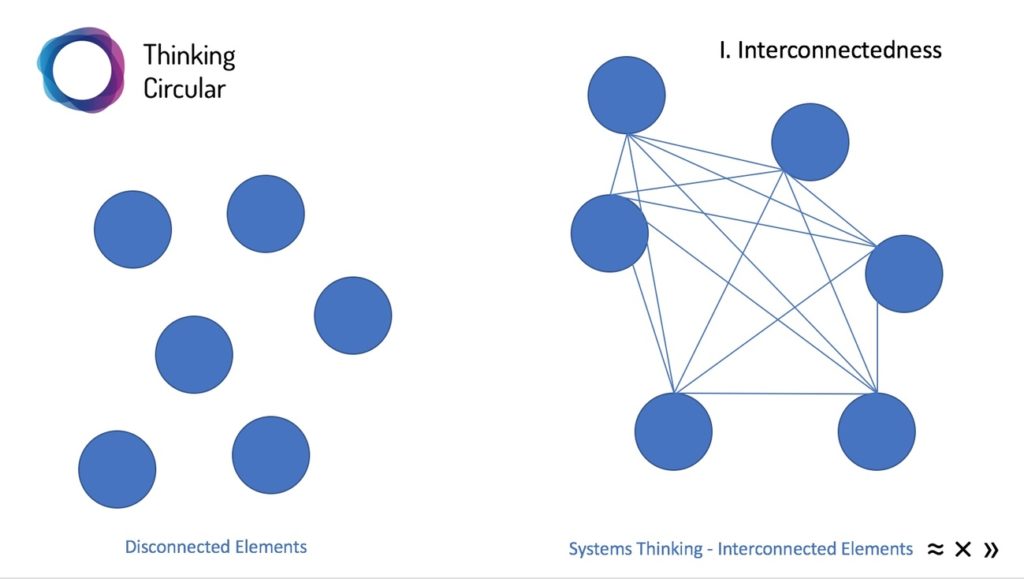
Circular Thinking is Systems Thinking
How can we deal with complex problem solving and transitioning? What can enable us to face global challenges? Is there still any chance to protect our climate and deal with upcoming changes? What can make us resilient and help us to manage crisis?
Methods
Research and applied sciences have presented methods of Systems Thinking. These allow the development and advancement for a systems mindset for dealing with complex problem solving and transitioning to the Circular Economy. The most important method is the Feeback-Loop. Action can either balance a system and produce stability and self-correcting or reinforce and lead to instability and exponential growth. Therefore the understanding of the mechanisms within the system is extremely relevant to find the correct trigger for actions to achieve a certain situation within the system.
The understanding of a few general characteristics of systems offers useful insights of mechanism. Observing these offers new perspectives on solving problems. The general characteristics are presented in this very short video:
Video zu den Methoden des Systems Thinking
- Interconnetedness
- Emergence
- Synthesis
- Relationships
- From linear to circular
- From parts to wholes
- Systems mapping
In Systems all elements are (1) interconnected. The interconnectedness is to be understood in a biological science way. Examples are natural biotopes, like ponds with fish in it. They show how dependent the individual creature is on other animals or living systems, where only by precise adoption to connected elements life can proceed. But even objects are dependent in this very same sense: a chair made out of wood can only be built if a tree had grown before. Our natural systems and resources were gained by nature over billion of years, so we can use them today. Discovering dependencies of elements, creatures and structures in nature will help us to live according to the rules of nature. Accepting nature as our partner, adopting natural rules for our economy, production, industry and culture will help us survive on this planet. Systems Thinking is a method and technique to explore natures rules and apply them in the design of the new.
Another method is the (2) emergence of systems, the outcome of the synergies of the parts. It is non-linear, self-organises and describes the outcome of things interacting together, for the (6) the parts than make the whole. Emergence is a very abstract concept of how life emerges from individual biological elements in diverse and unique ways.
When researchers structure their work (3) analysis of parts and synthesis of the parts are typical methods. Of course there is no synthesis without analysis of the parts. Systemic Thinking is therefore the ability to zoom in and out of the system focussing again and again of the synthesis and interaction between the single elements of the system. Doing so even the smallest things might show the most importance for the entire system. Negative reinforced influence on these elements might become a danger for the existence of the entire system. This is the reason why the extinction of species is so dangerous for others and in the end for us humans and all life on earth. Systems Thinkers believe that we haven’t even got a clue of the fatal systems feedbacks by species extinction.
This example makes clear that the (4) relationships between system elements, entire systems or species is a further relevant aspect. Today research has already explored many factors for the strengthening or enabling of relationships and others that could destroy them. Many disciplines go deeply into relationships: philosophy, psychology, sociology, politics. And we know that not only human beings but other species have special relationships, some of them show even very similar behaviour like aunts, bees or primates, who all live in big groups. Other species have shown us that they feel emotions like humans do. So we begin to understand that other species can also reflect on their lives, so there is consciousness, too. This makes clear how little we know about nature, elements and species. A great new experiences lies ahead, exploring all that!
(5) From linear to circular – flow: Air, water, temperature, elements – they are not interacting linear but they can be predicted to act in stable or unstable ways. The theory of flows, life-cycle assessments, flow analysis and others open a window of Systems Thinking for us and build the basis for a three dimensional circular understanding.
Last but not least the thought of Systems Thinking must be brought down and documented, clustered, prioritised e. g. The visualisation and presentation in (7) maps is a helpful tool. For example behaviour of species can be shown over periods of time in graphs and diagrams so that actions, emergences of other systems or external factors on the system can be explored. The iceberg Modell shows events, patterns, structures and mental models. Causal loop diagrams describe the causality of loops and connected circles boil down interconnectedness of elements.




No Comments